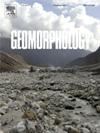Origin and evolution of slope-confined canyons and their relationship with gas hydrate accumulation in the northwestern Qiongdongnan Basin, South China Sea
IF 3.1
2区 地球科学
Q2 GEOGRAPHY, PHYSICAL
引用次数: 0
Abstract
Submarine canyons are important channels for sediment transportation in sloped areas and are key locations for the accumulation of gas hydrates and shallow gases. Understanding the evolution of submarine canyons and gas migration is crucial for natural gas exploration in the petroleum industry. In this study, we integrated bathymetric, seismic, logarithmic, and lithological data derived from slope-confined canyons in the Qiongdongnan Basin (QDNB) to examine their geomorphologies and filling patterns. This study has delved into the deposition processes, influencing factors, and evolutionary processes of these submarine canyons, as well as their relationship with gas hydrate accumulation. The results show five slope-confined submarine canyons in the study region, with water depths of 300–1700 m and NW-SE orientation. Canyon fills can be categorized into five types: turbidity-dominated muddy deposits, mass transport deposits, slumps, slides, and bottom current-dominated muddy deposits. These submarine canyons have developed from approximately 5.5 Ma and migrated toward the northeast. In addition, significant gas chimneys and bottom-simulating reflectors indicating gas hydrate accumulation were identified and were primarily located in the canyon ridge strata. Canyon evolution can be divided into three stages, with progression from turbidite channels to linear canyons, and eventually to dendritic canyons. The final evolutionary stage is closely linked to hydrate accumulation and decomposition. The canyon infillings controlled gas hydrate accumulation in the submarine canyon ridges. Gas hydrates located in the upper layer are prone to decomposition, promoting dendritic development of canyon walls. Gravity-flow activity through the evolution of slope-confined canyons is likely induced by factors such as high slope gradients, sea-level fluctuations, fault activity, hydrate decomposition, and earthquakes. The along-slope bottom currents reshaped the canyon landforms and facilitated their lateral migration.
求助全文
约1分钟内获得全文
求助全文
来源期刊

Geomorphology
地学-地球科学综合
CiteScore
8.00
自引率
10.30%
发文量
309
审稿时长
3.4 months
期刊介绍:
Our journal''s scope includes geomorphic themes of: tectonics and regional structure; glacial processes and landforms; fluvial sequences, Quaternary environmental change and dating; fluvial processes and landforms; mass movement, slopes and periglacial processes; hillslopes and soil erosion; weathering, karst and soils; aeolian processes and landforms, coastal dunes and arid environments; coastal and marine processes, estuaries and lakes; modelling, theoretical and quantitative geomorphology; DEM, GIS and remote sensing methods and applications; hazards, applied and planetary geomorphology; and volcanics.
 求助内容:
求助内容: 应助结果提醒方式:
应助结果提醒方式:


